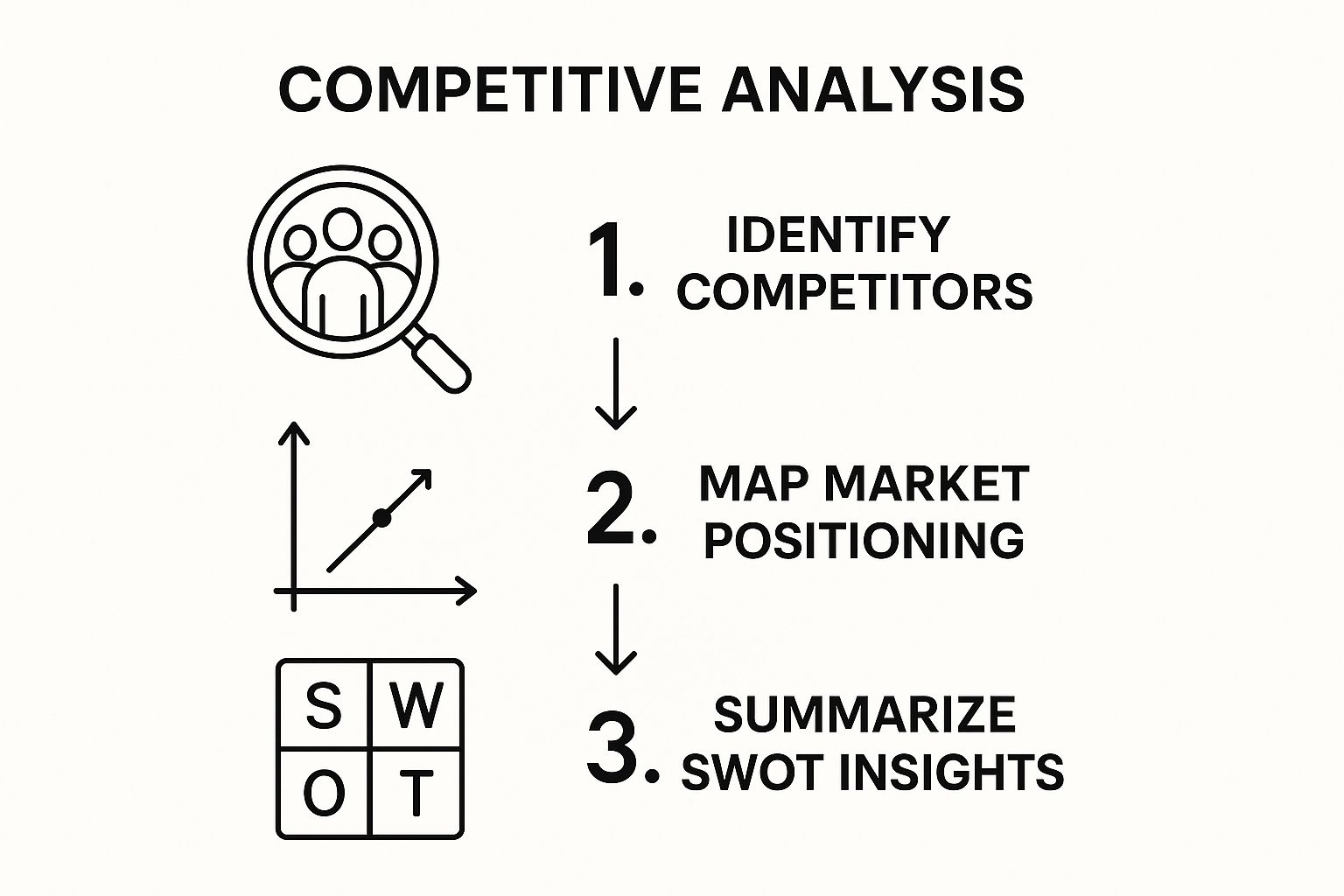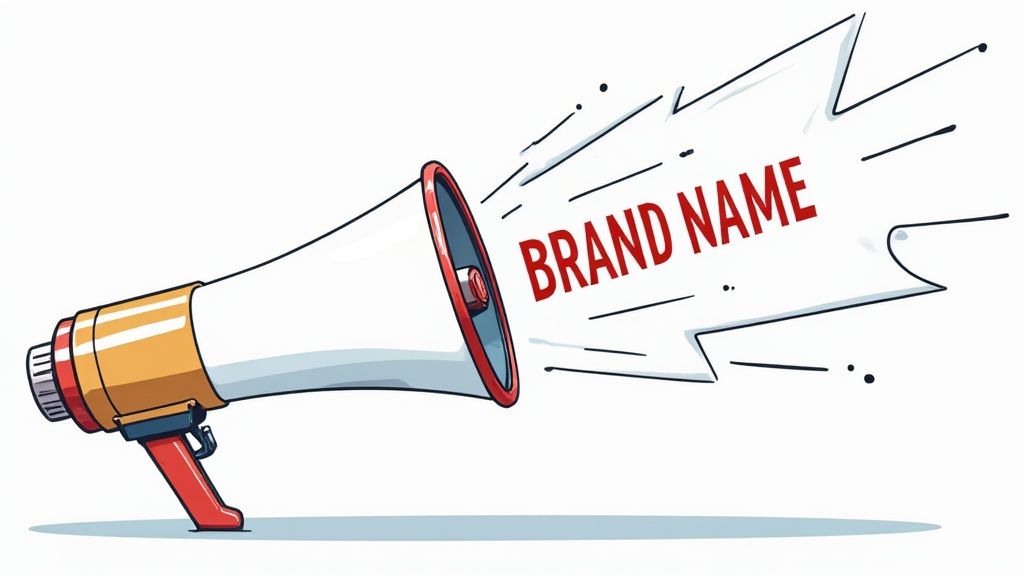A Better Brand Strategy Template That Works

You've probably seen them everywhere: fill-in-the-blank brand strategy templates promising a quick and easy path to brand clarity. But let’s be honest, building a brand that actually connects with people is rarely that simple. While these documents can offer a basic skeleton, they often miss the very thing that makes a brand memorable—its unique spark.
Why Generic Brand Templates Fail
The internet is absolutely flooded with one-size-fits-all brand strategy templates. They look like the perfect solution, don't they? A simple checklist for your mission, vision, and values. The problem is, just filling in boxes usually leads to a brand that feels robotic, forgettable, and totally disconnected from the people you want to reach. This cookie-cutter approach skips over the hard, nuanced work of building something that truly resonates.
A brand isn't just a list of statements. It's a living, breathing thing with a real personality and a voice people can recognize. Generic templates just can't capture that soul.
The Problem with a Fill-in-the-Blank Approach
Most standard templates force you to think in separate boxes—logo goes here, mission statement over there. This fragmented process completely misses the bigger picture, and that’s where inconsistencies creep in and start confusing your customers.
Imagine a startup uses a template and decides its brand voice is "playful and witty." But when a customer actually interacts with their support team, the experience is rigid and formal. Right there, the brand feels fake.
This disconnect is where so many brands stumble. A powerful brand strategy makes sure every single touchpoint—from an Instagram post to a shipping confirmation email—feels like it’s coming from the same place.
Think of a brand strategy template as a starting point, not the final destination. It's meant to guide your thinking, not hand you pre-packaged answers that water down what makes your company special.
Authenticity Trumps a Perfect Template
Building a real connection with customers is everything. In fact, a staggering 81% of consumers say they need to trust a brand before they’ll even think about buying from it. On top of that, 57% prefer to buy from brands they feel a genuine connection with. You can't manufacture that kind of authenticity from a generic document.
For more on how brand strategy aligns teams and builds trust, check out these branding insights on asana.com.
Think about a local coffee shop. A generic template might have them define their target audience as "urban professionals aged 25-40." Sure, that might be technically correct, but it completely ignores the real people walking through the door: the freelancers looking for a quiet corner, the students cramming for finals, or the community group that meets there every Tuesday.
An effective strategy dives into those human stories. It shapes a brand that feels like a real part of the neighborhood, not just another business.
Ultimately, this is about a mindset shift. You’re not just trying to complete a document. You're building a living strategy that captures your company's unique spirit and drives real, lasting growth.
Crafting Your Brand's Foundation

Before you ever touch a logo design, dream up a tagline, or pick out a color palette, you have to pour the foundation. This is the bedrock of your brand—the stuff that gives it meaning and a clear path forward. Without it, all you're doing is creating pretty visuals with no real soul.
This is where we get serious. We're digging past the surface level and getting into the core elements that will steer every single decision your business makes. We’re talking about your purpose, your vision for the future, and the unwavering principles that define who you are. These aren't just fluffy buzzwords to hang on an office wall; they're the load-bearing pillars of a brand built to last.
Defining Your Unshakable 'Why'
Every great brand starts with a powerful "Why"—its core purpose that goes way beyond just making a profit. Why does your company even exist? What problem are you genuinely passionate about solving for your customers?
Nailing this down is the single most important step you can take. It’s what allows you to connect with people on a human level. A compelling purpose statement becomes the emotional heartbeat of your brand, inspiring your team and drawing in customers who see you as more than just a provider of a product or service. This is your brand's true north.
For example, a sustainable clothing brand’s purpose isn't just to "sell eco-friendly apparel." That's flat. A much stronger 'Why' would be something like: "To empower conscious consumers to express their style without compromising the health of our planet." Now that's inspiring, specific, and gives them a clear filter for every decision they make.
Your brand's 'Why' is its ultimate reason for being. It’s the story that creates an emotional bond with your audience, turning customers into genuine advocates for what you stand for.
Articulating a Clear Mission and Vision
Once your purpose is set in stone, the next move is to spell out your mission and vision. People often use these terms interchangeably, but they play very different—and equally vital—roles in your brand strategy template. Think of them as your brand's compass and its ultimate destination.
Your mission statement is your roadmap for right now. It defines what your company does, who you do it for, and what makes you different. It’s grounded in the present and lays out the practical actions you're taking to live out your purpose. A good mission is actionable and crystal clear.
Your vision statement, on the other hand, is your destination. It's a bold, aspirational picture of the future you're trying to create. It should be big enough to get your team and stakeholders excited, painting a picture of the impact you plan to have on the world.
Let's see how this plays out in the real world:
- Mission (The How): "To provide small businesses with intuitive, AI-powered tools that transform their ideas into compelling visual stories."
- Vision (The What): "To become the leading platform where every creator, regardless of skill level, can build a powerful digital presence."
See the difference? This structure provides both immediate direction for today and long-term inspiration for tomorrow, making sure every action is pulling toward the same big goal.
Establishing Non-Negotiable Core Values
Your core values are the non-negotiable principles that guide how your company behaves. They define your culture. They are the promises you make—to your customers, to your team, and to yourselves. These values are the rulebook for everything from product development to customer service calls.
When you're defining your values, try to avoid generic words like "integrity" or "innovation" unless you're ready to define exactly what they look like in action. What does "integrity" actually mean in your day-to-day operations? Does it mean transparent pricing? Or does it mean owning up to mistakes the second they happen? Get specific.
Here are a few examples of well-defined core values that actually mean something:
- Embrace Curiosity: We constantly ask "what if" and are always looking for new ways to solve problems for our customers.
- Customer-Obsessed: We listen intently to feedback and put the user's success at the absolute center of every decision we make.
- Simplicity Wins: We believe powerful tools don't need to be complicated. We fight for clarity in our design and our communication.
These foundational pieces—purpose, mission, vision, and values—aren't meant to be set in stone forever. They're living parts of your brand that you should revisit and refine as your business evolves. Just as you need a brand strategy template to organize your thoughts, understanding key product strategy frameworks can give you a solid structure for crafting this foundation and aligning your product with your brand vision. That alignment is critical; it ensures that what you build and how you build it are always in perfect sync with the brand you want to be.
Defining Your Brand Personality And Voice

If your brand walked into a party, what would it be like? The witty life of the party? The wise mentor offering thoughtful advice? Or maybe the high-energy innovator buzzing about what’s next?
That’s the core of brand personality—giving your business human traits. Nailing this down in your brand strategy template is non-negotiable because it shapes every single conversation you have with your audience.
A strong personality makes your brand feel less like a faceless corporation and more like a trusted friend. It’s what makes you memorable and relatable.
Choosing Your Brand Archetype
A fantastic starting point for defining your personality is to look at brand archetypes. These are basically universal character types that people just get on an instinctive level. Using them is like a shortcut to a personality your audience will connect with.
There are twelve main archetypes, and each has its own unique motivations and values. Finding the one that clicks with your brand’s purpose gives you a solid foundation to build your voice and messaging on.
Here are a few in action:
- The Hero: Think Nike or Adidas. These brands are all about determination, courage, and overcoming obstacles. Their voice is confident and always motivational.
- The Sage: Google and PBS are perfect examples. They’re driven by knowledge, wisdom, and the pursuit of truth. Their voice is authoritative, informative, and educational.
- The Jester: Brands like Old Spice and M&M's just want to have a good time. They live to make people laugh and enjoy the moment, so their voice is playful, witty, and often a little bit irreverent.
- The Caregiver: This is Johnson & Johnson or Dove. They are compassionate, nurturing, and protective. Naturally, their voice is warm, empathetic, and reassuring.
Picking an archetype gives your communication a clear direction. It keeps your brand from sounding inconsistent and ensures every tweet, email, and blog post reinforces the same identity.
Your brand archetype isn't just a fun label; it's a strategic tool. It guides your storytelling, shapes your visuals, and makes sure you’re hitting the right emotional notes with your audience.
From Personality To A Practical Voice Guide
Once you’ve settled on a personality, you need to translate it into a practical tone of voice. This is where your brand strategy template gets really specific, laying out the ground rules for how your brand actually communicates.
Think of it this way: your brand voice is the consistent, underlying personality. Your tone is how that voice adapts to different situations.
For instance, your voice might always be "empowering and helpful." But the tone you use in a celebratory social media post will be way more enthusiastic than the tone in a support email addressing a customer's problem.
Creating a guide for this is essential for consistency, especially as your team grows. This should be a go-to resource for everyone, from marketers to customer service reps, to keep everyone sounding like your brand. It's a core piece of what you'd find in a comprehensive brand style guide template.
Crafting Your Do's and Don'ts
The best voice guides I've seen always include a simple "Do's and Don'ts" chart. It’s the easiest way to make an abstract idea like "voice" concrete and actionable for your whole team.
Let's imagine a brand with a "Friendly Expert" personality. Their guide might look something like this:
| Our Voice Is... | Do Say | Don't Say |
|---|---|---|
| Clear & Simple | "Let's walk through the steps together." | "We must now initiate the required procedure." |
| Confident | "Here’s the best way to get that done." | "You could maybe try doing this..." |
| Empathetic | "We understand this can be tricky." | "This is a common user error." |
| Approachable | "Feel free to ask us anything!" | "Submit a query via the contact form." |
This simple chart cuts through the ambiguity and empowers everyone to communicate with one, unified voice.
To make sure that voice is heard, consider developing a social media marketing strategy that reflects your brand persona. This ensures your carefully crafted personality translates into an engaging online presence where your audience actually hangs out.
Finding Your Audience And Market Position
You can't be everything to everyone. Honestly, you shouldn't even want to be. The brands that truly win aren't the ones trying to capture the entire market; they're the ones that become the absolute first choice for a specific group of people.
This is the part of your brand strategy where you stop guessing and start getting crystal clear on who those people are and where you fit into their world.
Building Your Ideal Customer Persona
It all starts by ditching the flat, lifeless demographics. "Men aged 18-34" tells you next to nothing. We need to build out detailed user personas that feel like real people with actual goals, daily frustrations, and deep-seated motivations.
A user persona is just a fictional character who embodies your ideal customer. When you give this person a name, a job, and a backstory, it suddenly becomes so much easier to build a brand that speaks directly to them. This isn't about making things up; it's about digging into the real needs of the people you want to serve.
When you're filling out this section in your template, focus on a few key questions:
- Goals: What are they trying to achieve? What does success look like in their world?
- Challenges: What’s getting in their way? What problems keep them up at night?
- Motivations: What really drives their decisions? Are they chasing status, convenience, security, or something else entirely?
- Watering Holes: Where do they hang out, online and off? Which blogs, podcasts, or influencers have their attention?
Answering these questions transforms your target audience from a faceless statistic into a living, breathing person you can actually help. For a much deeper dive, check out our guide on how to run a complete target audience analysis. This step is non-negotiable—it gives your brand a clear "who" to talk to.
Analyzing The Competitive Landscape
Once you know who you're talking to, you have to figure out who else is talking to them. A competitive analysis isn't about copying what your rivals are doing. Think of it as a strategic mission to find the gaps in the market they’ve left wide open for you.
Your brand strategy template absolutely needs a section for this reality check.

Map out your top three to five competitors and look at them through the eyes of your ideal customer. Analyze their messaging, visual identity, pricing, and what their customers are saying in reviews. What are they nailing?
Even more importantly, where are they dropping the ball? That’s where your opportunity is hiding.
Crafting Your Unique Positioning Statement
Okay, now that you have a sharp picture of your audience and the competitive playing field, it's time to craft a powerful brand positioning statement.
This isn't some public-facing tagline. It's an internal North Star that guides every single marketing and branding decision you make. It's arguably the most important sentence in your entire brand strategy template.
A strong positioning statement is built on a simple framework that forces clarity. You need to define your audience, your market, your key differentiator, and the proof that backs it up.
Here is a simple table to walk you through it.
| Brand Positioning Framework |
| :--- | :--- | :--- |
| Framework Component | Description | Example (For a sustainable coffee brand) |
| Target Audience | The specific group of people you're here to serve. | "Environmentally conscious coffee lovers" |
| Market Category | The industry or frame of reference you operate in. | "the at-home coffee brand" |
| Point of Difference | Your unique value—what makes you the best choice. | "that offers 100% compostable pods" |
| Reason to Believe | The proof or evidence that supports your unique claim. | "because we source directly from Rainforest Alliance Certified™ farms and use plant-based materials." |
Putting these pieces together gives you a clear, defensible statement that sets you apart.
Let’s bring this to life with a formula and a different example. Imagine a project management software built just for creative agencies.
For [Target Audience], [Your Brand] is the [Market Category] that delivers [Point of Difference] because [Reason to Believe].
Here’s how it looks filled in:
"For creative agency leaders overwhelmed by chaotic workflows, our platform is the only project management tool that integrates visual feedback directly into task management, because it was designed by agency veterans who understand the creative process firsthand."
See how specific and defensible that is? It immediately carves out a unique space in the market. This statement becomes the ultimate gut check for everything you do, ensuring your brand stays focused, consistent, and undeniably relevant to the people who matter most.
Bringing Your Strategy To Life Visually

This is where the magic happens—where all the words, ideas, and foundational work we’ve done so far become something people can actually see and feel. It’s the moment your strategy gets a face.
Every visual choice you make from this point on has to be a direct reflection of the strategy you’ve already built. This isn’t about picking your favorite colors or a cool-looking font. It’s about making smart, deliberate decisions that reinforce your brand’s personality and promise.
A beautiful design without a solid strategy behind it is just art. A smart identity, on the other hand, creates a powerful, lasting connection with your audience.
Your Logo Is Not Your Brand
Let's get one of the biggest misconceptions out of the way immediately: your logo is not your brand. Yes, it’s an essential symbol—a visual shorthand for everything you stand for—but it's just one piece of a much larger puzzle.
Your brand is the entire experience. It's the gut feeling people have when they interact with you.
Think of your logo as the cover of a book. It needs to be compelling and give a hint of the story inside, but it isn't the whole story. Your complete visual identity (logo, colors, fonts, imagery) is the language that tells that story consistently, page after page. Your brand strategy template should have a dedicated space to break down the core concept behind your logo. What story is it telling at a glance?
Your visual identity is the uniform your brand wears. It should be instantly recognizable and perfectly suited for every occasion, from a formal presentation to a casual social media post, ensuring you always look and feel like yourself.
The Psychology of Your Color Palette
Color is an incredibly powerful tool. It’s one of the first and fastest ways you communicate without using a single word. The right palette can stir up emotions, build trust, and even guide buying decisions before anyone reads your copy. In fact, studies show that color can boost brand recognition by up to 80%.
When you're picking colors, circle back to your brand archetype and personality traits. Is your brand a wise Sage? Deep blues and grays can project intelligence and authority. Are you more of a playful Jester? Bright yellows and oranges might be a better fit to communicate fun and optimism.
A well-structured palette usually includes:
- Primary Colors: One to three core colors that will become most associated with your brand.
- Secondary Colors: Two to four complementary colors used for accents, highlights, and other design elements.
- Neutrals: Shades like white, black, gray, or beige to create balance and make sure everything is easy to read.
This system keeps your visuals vibrant and interesting without ever feeling chaotic or off-brand. It’s a crucial piece of building an effective visual brand strategy that holds up in the real world.
Choosing Fonts That Speak Volumes
If color is about feeling, typography is your brand’s voice in written form. Just like your spoken tone, your fonts have a distinct personality. A clean, modern sans-serif like Helvetica feels efficient and direct. A classic serif font like Garamond can feel more traditional and trustworthy.
The goal is to pick a font pairing that not only reflects your brand’s character but is, above all, readable. A simple system with two or three fonts is usually a great place to start:
- A Primary Headliner Font: For your main titles and headings. This one should be distinctive and really capture the personality you defined earlier.
- A Secondary Body Font: This is for longer paragraphs of text. The absolute priority here is clarity and readability on any screen.
- An Accent Font (Optional): You might use a third font sparingly for things like call-to-action buttons or special callouts.
By defining these roles in your brand strategy template, you create a clear typographic hierarchy. This simple structure makes your content much easier for people to scan and absorb.
Curating A Cohesive Imagery Style
Finally, let's talk about imagery. Your photography, illustrations, and icons all need to feel like they belong to the same world. Are your brand photos bright, airy, and full of smiling faces? Or are they more moody, high-contrast, and cinematic?
There isn't a right or wrong answer here—only what’s right for your brand. Setting clear guidelines for your imagery helps you avoid the common trap of using generic stock photos that just dilute your brand’s unique feel. Define the mood, subject matter, and even the editing style so that every single image reinforces the story you’re trying to tell.
When all these visual elements—logo, color, typography, and imagery—work together in harmony, they create an unmistakable identity. That consistency is what builds recognition and trust, turning your hard work on strategy into a living, breathing brand that people connect with instantly.
How To Measure And Evolve Your Brand
So, you've built your brand strategy. Now what? Don't just file it away and call it a day. A brand strategy isn't a trophy for the shelf; it's a living, breathing tool that needs to prove its worth out in the real world.
A strategy that looks brilliant on paper is completely useless if it doesn't actually connect with customers or drive results. The real work begins the moment you put it into action.
This means you need a consistent rhythm of measurement and refinement. A static brand quickly becomes an irrelevant one. The goal is to create a constant feedback loop—listen, learn, and adjust—to make sure your brand stays powerful and in tune with your audience for the long haul.
Setting Up Your Brand Dashboard
To figure out if your strategy is actually working, you have to track the right numbers. Gut feelings are great, but they won't cut it here. You need concrete key performance indicators (KPIs) that tell a clear, unbiased story about your brand's health. Think of this as your brand’s cockpit, giving you an at-a-glance view of your performance.
Your dashboard should be a mix of metrics that cover all the important angles:
- Brand Awareness: Keep an eye on social media mentions, your share of voice in the market, and direct website traffic. Are more people talking about you and seeking you out this month compared to the last?
- Customer Sentiment: Use social listening tools and survey feedback to get a read on how people feel about you. Is the chatter positive, negative, or just neutral?
- Engagement Rates: This is your gut check for content. Monitor likes, comments, shares, and email open rates. These numbers tell you if what you're saying is actually hitting home.
- Loyalty and Retention: Track metrics like customer lifetime value and repeat purchase rates. Loyal customers are the ultimate sign of a strong brand connection.
The Power of Data-Driven Decisions
The most successful brands aren't guessing anymore. They're built on a solid foundation of data and a willingness to adapt. In fact, brands that lean into data-driven strategies often see up to a 60% better alignment between customer perception and actual business performance. This really drives home how critical analytics are in a modern brand strategy.
This means your strategy should be built to evolve from the start. Treat every marketing campaign like an experiment. Start with a hypothesis, test it in the market, measure the results against your KPIs, and use what you learn to make your next move even smarter.
Your brand strategy isn't a final answer; it's a living hypothesis. The market provides the data you need to prove, disprove, or refine it over time. This iterative process is what separates enduring brands from fleeting trends.
Creating a Rhythm of Review and Refinement
Finally, you need a system for gathering feedback and making smart adjustments. This isn’t a once-a-year thing; it should be woven into the fabric of your operations. A huge piece of this puzzle is learning how to get customer feedback effectively, as this keeps your strategy grounded in what your users actually need and want.
Schedule regular check-ins—monthly or quarterly works well—to review your brand dashboard with your team. Dig into the data, have honest conversations about what’s working and what isn’t, and then decide on clear, actionable steps for the next cycle. This disciplined approach is what turns your brand strategy from a static document into a dynamic engine for growth.
Ready to transform your content into stunning visual carousels that captivate your audience? With Lumeo, you can effortlessly create engaging presentations from articles, videos, or even tweets, all powered by AI. Start building your digital presence and driving real engagement today. Discover what you can create with Lumeo.